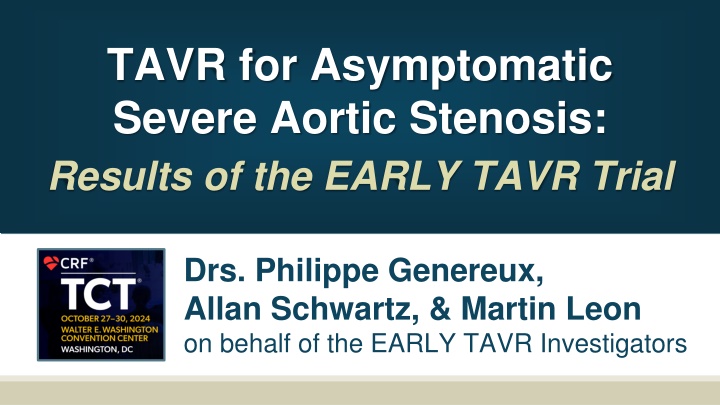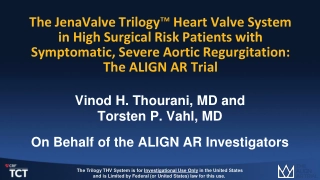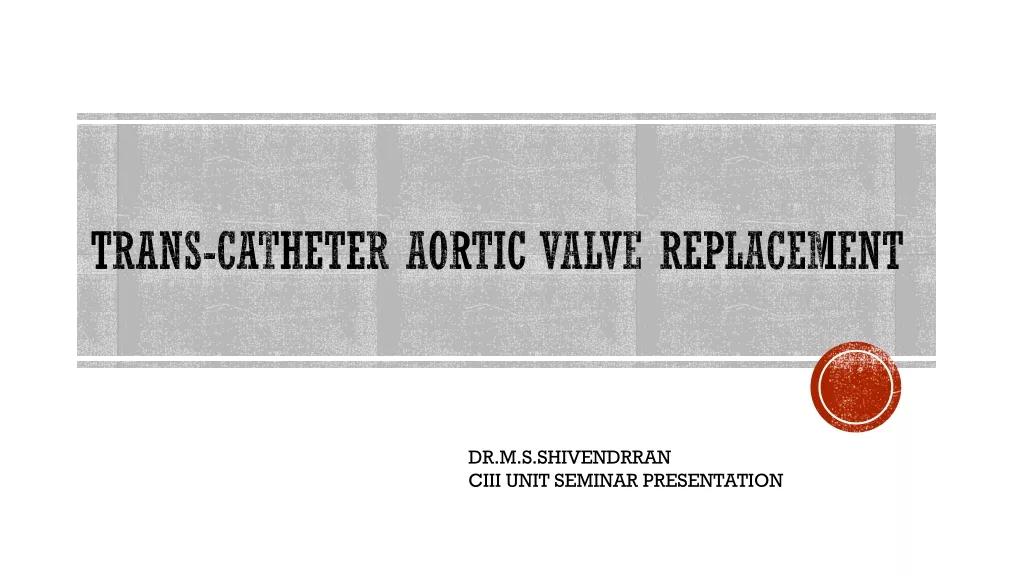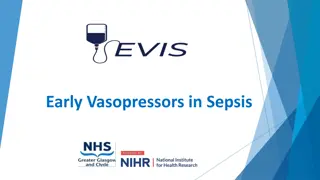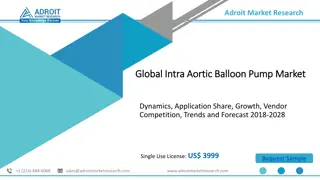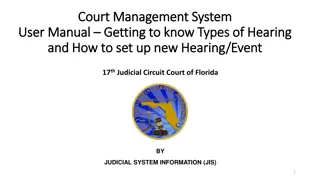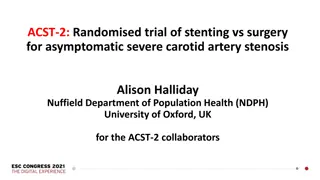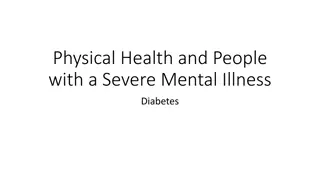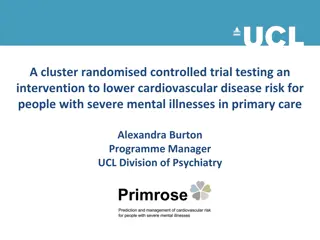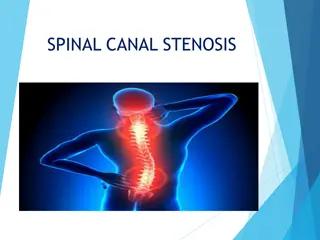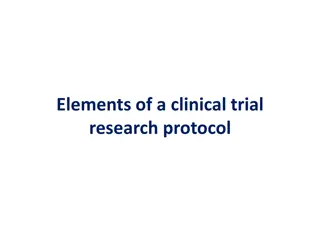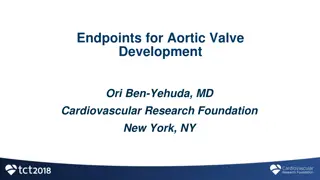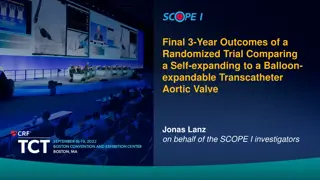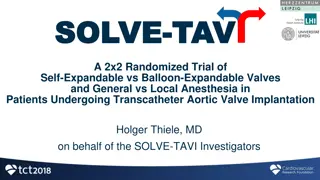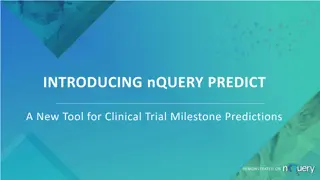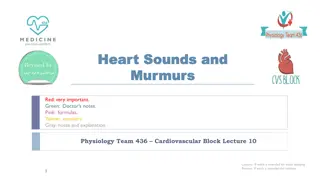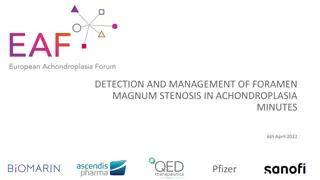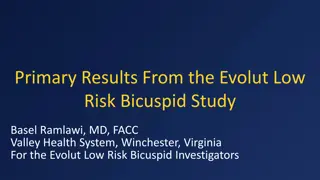Early TAVR Trial for Asymptomatic Severe Aortic Stenosis
Prospective multicenter RCT evaluating TAVR vs clinical surveillance in asymptomatic severe AS patients aged 65+ with STS score
Download Presentation

Please find below an Image/Link to download the presentation.
The content on the website is provided AS IS for your information and personal use only. It may not be sold, licensed, or shared on other websites without obtaining consent from the author.If you encounter any issues during the download, it is possible that the publisher has removed the file from their server.
You are allowed to download the files provided on this website for personal or commercial use, subject to the condition that they are used lawfully. All files are the property of their respective owners.
The content on the website is provided AS IS for your information and personal use only. It may not be sold, licensed, or shared on other websites without obtaining consent from the author.
E N D
Presentation Transcript
TAVR for Asymptomatic Severe Aortic Stenosis: Results of the EARLY TAVR Trial Drs. Philippe Genereux, Allan Schwartz, & Martin Leon on behalf of the EARLY TAVR Investigators
Background For patients with asymptomatic severe AS and preserved LVEF ( 50%), current ACC/AHA guidelines recommend clinical surveillance (CS) with routine follow-up every 6 to 12 months Recently, 2 small RCTs1,2 evaluating younger patients with very severe AS demonstrated a benefit for early surgical AVR compared to clinical surveillance To date, no trial has explored a strategy of early TAVR compared to guideline-indicated clinical surveillance 1Kang et al. N Engl J Med 2020;382(2):111-119; 2Banovic et al. Eur Heart J 2024;ehae585
Purpose To determine the safety and effectiveness of a strategy of early intervention with TAVR compared to clinical surveillance in patients with asymptomatic severe AS.
Study Design Prospective, multicenter RCT evaluating patients with asymptomatic, severe AS aged 65 years w/ an STS score 10% and LVEF 50% Asymptomatic Assessment Confirmed by negative stress test* Randomization 1:1 Transfemoral-TAVR (SAPIEN 3 or SAPIEN 3 Ultra THV) Clinical Surveillance PRIMARY ENDPOINT (Superiority) Non-hierarchical composite of all-cause death, any stroke, or unplanned CV hospitalization at a minimum follow-up of 2 years *Confirmed by detailed clinical history alone if patient was unable to perform stress test
EARLY TAVR Clinical Sites Hamilton Health Sciences University of Ottawa Toronto General Hospital CANADA Providence Everett Northwestern University Endeavor Health Rochester General Hospital University at Buffalo University of Washington Rush University Sacred Heart Medical Center Dartmouth-Hitchcock Medical Center Alexian Brothers Hospital Network Cleveland Clinic St. Patrick Hospital Kaiser Portland Maine Medical Center CentraCare Heart & Vascular Minneapolis Heart Institute Foundation University of Minnesota Medical College of Wisconsin Brigham and Women s Hospital Cape Cod Hospital Henry Ford Hospital Albany Medical College Yale University Allegheny General Hospital Mayo Clinic Kaiser San Francisco Medical Center Bay Area Structural Heart at Sutter Health Stony Brook University Ohio Health Research Institute Iowa Heart Center Winthrop-University Hospital Montefiore Medical Center UC Davis Intermountain Medical Center Mount Carmel Health System University of Iowa Medical Center of the Rockies Columbia University Cornell Medical Center NYU Langone Stanford University Prairie Education & Research The Christ Hospital St. Luke s Hospital Cardiovascular Research Institute of Kansas Newark Beth Israel Medical Center Morristown Medical Center Lankenau Medical Center Pinnacle Health Harrisburg York Hospital University of Maryland Huntington Hospital Vanderbilt University Cedars-Sinai Medical Center Hoag Memorial Hospital The Heart Hospital Baylor Plano Banner University Emory University Piedmont Heart Institute Washington Hospital Center Texas Health Dallas CAMC Clinical Trials Center Inova Heart and Vascular Institute Sentara Norfolk General Hospital University of Virginia Carilion Medical Center North Carolina Heart & Vascular Atrium Health University of Florida Ochsner Clinic Foundation 72 US Sites 97.6% (879 pts) 3 Canadian Sites 2.4% (22 pts) UT Health Science Center at Houston The Cardiac & Vascular Institute Research Foundation
Key Inclusion Criteria Age 65 years Severe aortic stenosis AVA 1.0 cm2or AVA index 0.6 cm2/m2 AND Mean gradient 40 mmHg or peak jet velocity 4.0 m/s LV ejection fraction 50% Asymptomatic Negative stress test and detailed clinical history OR Detailed clinical history alone if patient is unable to perform a stress test (e.g., due to orthopedic reasons) STS score 10%
Key Exclusion Criteria Class I indication for AVR Unsuitable anatomy for TF-TAVR using the S3/S3 Ultra valve (Bicuspid valves w/ favorable anatomy for TAVR were permitted) Severe AR or MR (>3+) or moderate mitral stenosis Renal insufficiency (eGFR <30 mL/min/ 1.73 m2) and/or renal replacement therapy Severe lung disease or severe pulmonary hypertension Pre-existing mechanical or bioprosthetic valve in any position Active COVID-19 infection or previous diagnosis with sequelae
Primary Endpoint Composite of all-cause mortality, any stroke, or unplanned CV hospitalization Tested for superiority in the intent-to-treat population after a minimum follow-up of 2 years Unplanned CV hospitalization was defined as follows: Any CV hospitalization through an ED or admission from clinic for therapy intensification* or lasting 24h Any aortic valve intervention (CS arm) or reintervention (TAVR arm) that occurred within 6 months(minimum guideline-indicated follow-up) *Includes IV diuretics, 50% increase in drug therapy dosages, or addition of new pharmacotherapy agents
Secondary Endpoints (Hierarchical) 1. Favorable Health Status Outcome* Alive at 2Y w/ a KCCQ score 75 that did not decrease by > 10 points from baseline 2. Integrated LV/LA health at 2 years composite of: LV global longitudinal strain (GLS) 15% and LV mass index < 115 g/m2 for men or < 95 g/m2 for women and LA volume index 34 mL/m2 3. Change in LVEF from baseline to 2 years 4. New-onset atrial fibrillation 5. Death or disabling stroke *Evaluated at 2Y; If an AV intervention/reintervention occurred within 6M, pre-procedure (CS) or 30D (TAVR) KCCQ score was used
Patient Flow N=1578 Patients consented for screening between March 2017 and December 2021 Excluded from randomization N=677 (42.9%) 313 Class I indications for AVR 277 Symptomatic severe AS 34 Other cardiac indication 2 Asym. severe AS, LVEF < 50% 213 Anatomical exclusions 32 < Severe AS 29 Medical exclusions 24 Other exclusions 66 Withdrew consent Enrolled and randomized 1:1 N=901 at 75 sites Transfemoral TAVR N=455 Clinical Surveillance N=446
Patient Follow-up Transfemoral TAVR N=455 Clinical Surveillance N=446 Minimum follow-up 2 years Median follow-up 3.8 years 12 Withdrawn 1 Lost to follow/up 11 Withdrawn 442 (97.1%) available for primary analysis 435 (97.5%) available for primary analysis Primary analysis evaluated in the ITT population
Baseline Characteristics TAVR (N=455) 76.0 6.0 28.8% 28.4 4.6 1.8 1.0 83.5% CS TAVR (N=455) 8.1% 15.6% 4.6% 5.1% 4.2% 29.2% 7.3% 81.1% 26.2% CS Characteristic Characteristic (N=446) 75.6 6.0 33.0% 28.6 4.8 1.7 1.0 83.9% (N=446) 8.8% 13.2% 2.0% 4.0% 4.5% 25.3% 4.7% 81.8% 25.6% Age, y Female sex BMI, kg/m2 STS score, % Low-risk per Heart team Asymptomatic Criteria By stress test By clinical history only* KCCQ Score Bicuspid valve Hx of afib Pacemaker Prior MI Prior stroke CAD PVD HTN Diabetes eGFR <45 mL/min/ 1.73 m2 90.3% 9.7% 92.7 8.7 276 (139, 599) 90.8% 9.2% 92.7 9.4 297 (148, 608) 6.8% 4.5% NT-proBNP, pg/mL Values presented as %, mean SD, or median (IQR) *Unable to take the stress test for orthopedic and/or neurologic reasons P<0.05 at baseline
Baseline Echo Characteristics TAVR (N=455) CS Characteristic (N=446) 0.9 0.2 0.8 0.2 AVA, cm2 4.3 0.5 4.4 0.4 Peak velocity, m/s 46.5 10.1 47.3 10.6 Mean gradient, mmHg 67.4 6.5 67.4 6.7 LVEF, % 42.7% 37.3% LV diastolic dysfunction Grade II Values presented as % or mean SD
Primary Endpoint 60 CS TAVR Unplanned CV Hosp (%) HR [95%CI]: 0.50 [0.40, 0.63] p < 0.001 51.2% Death, Stroke, or 40 35.1% 37.5% 20 NNT at 2Y ~6 17.7% Median follow-up 3.8 years 0 0 12 24 36 48 60 Months from Randomization No. at risk: TAVR CS 455 446 390 305 363 266 285 187 142 117 103 46 Event rates are Kaplan-Meier estimates Patients had a minimum follow-up of 2 years
Primary Endpoint Components TAVR (N=455) CS Endpoint % (no. of pts) P-value (N=446) Primary Endpoint 26.8% (122) 45.3% (202) <0.001 All-cause Death 8.4% (38) 9.2% (41) --- Any Stroke 4.2% (19) 6.7% (30) --- Unplanned CV Hospitalization 20.9% (95) 41.7% (186) --- Median follow-up of 3.8 years
All-cause Death 60 Median follow-up 3.8 years CS TAVR All-cause Death (%) HR [95%CI]: 0.93 [0.60, 1.44] p = 0.74 40 20 13.6% 13.4% 3.6% 2.7% 0 0 12 24 36 48 60 Months from Randomization No. at risk: TAVR CS 455 446 439 436 425 418 346 310 187 199 136 95 Event rates are Kaplan-Meier estimates Patients had a minimum follow-up of 2 years
Stroke 60 Median follow-up 3.8 years CS TAVR HR [95%CI]: 0.62 [0.35, 1.10] p = 0.10 40 Stroke (%) 20 3.7% 9.5% 5.4% 2.7% 0 0 12 24 36 48 60 Months from Randomization No. at risk: TAVR CS 455 446 433 429 415 406 335 295 180 185 130 87 Event rates are Kaplan-Meier estimates Patients had a minimum follow-up of 2 years
Unplanned CV Hospitalization 60 CS TAVR Unplanned CV Hosp (%) HR [95%CI]: 0.43 [0.33, 0.55] p < 0.001 46.7% 40 36.3% 26.3% 20 15.1% Median follow-up 3.8 years 0 0 12 24 36 48 60 Months from Randomization No. at risk: TAVR CS 455 446 392 306 365 267 287 189 142 118 103 46 Event rates are Kaplan-Meier estimates Patients had a minimum follow-up of 2 years
Primary Endpoint Subgroup Analyses Subgroups Intent-to-treat (N=901) Sex Male (n=623) Female (n=278) Baseline STS Score < 3% (n=807) 3% (n=94) Ability to Perform Stress Test No (n=85) Yes (n=816) Baseline Jet Velocity (per Core Lab) < 5 m/s (n=818) 5 m/s (n=74) HR [95% CI] 0.50 [0.40, 0.63] Pinteraction 0.26 0.46 [0.35, 0.60] 0.61 [0.41, 0.90] 0.24 0.47 [0.37, 0.60] 0.66 [0.38, 1.17] 0.73 0.54 [0.30, 0.98] 0.49 [0.39, 0.63] 0.59 0.49 [0.38, 0.62] 0.60 [0.29, 1.28] 0 1 10 0.1 TAVR Better CS Better
Death, Stroke, or Hosp. for HF* Hospitalization for HF* (%) 60 CS TAVR HR [95%CI]: 0.60 [0.44, 0.83] p = 0.002 Death, Stroke, or 40 27.8% 20.2% 20 12.5% 6.5% Median follow-up 3.8 years 0 0 12 24 36 48 60 Months from Randomization No. at risk: TAVR CS 455 446 431 410 412 376 331 268 175 163 128 77 *Hosp for symptomatic CHF treated with IV diuresis, inotropic therapy, IABP, ventilation for pulmonary edema, or hemodialysis for vol. overload
Pre-specified Secondary Endpoints TAVR (N=455) CS Endpoint % or mean SE Treatment Effect [95% CI] P-value (N=446) 1. Favorable Health Status Outcome* 86.6% 68.0% <0.001 Abs : 18.5% [12.6%, 24.3%] 2. Integrated LV/LA health at 2Y 48.1% 35.9% 0.001 Abs : 12.2% [4.4%, 19.4%] -1.2 0.4 -1.3 0.4 Abs : 0.1 [-0.8, 1.3] 0.66 3. LVEF (%) from baseline to 2Y 4. New onset atrial fibrillation 13.0% 12.4% HR: 1.08 [0.73, 1.60] --- 5. Death or disabling stroke 9.7% 11.2% HR: 0.87 [0.58, 1.31] --- *Evaluated at 2Y and defined as alive w/ a KCCQ score 75 that did not decrease > 10 points from baseline; if AV intervention/reintervention occurred w/in 6 mos, pre-procedure (CS) or 30-day (TAVR) KCCQ score was used Defined as meeting all of the following criteria: LV GLS 15%, LVMi < 115 g/m2 for men or <95 g/m2 for women, andLAVi 34 mL/m2
Time to Conversion to AVR 100 95.2 90.4 Conversion to AVR (%) 86.1 71.4 80 47.2 60 40 26.2 Median time to conversion: 11.1 months 20 0 6 0 12 24 36 48 60 Months from Randomization No. at risk: CS 446 231 119 45 22 9 326 Median follow-up 3.8 years; At the time of analysis, 30 patients were still on study but hadn t converted to AVR
AVR Conversions With Symptoms Total (N=377) CS Patients who Converted to AVR with Symptoms Most Common Symptoms* Dyspnea Angina Dizziness Fatigue Syncope Multiple Symptoms Experienced 2 symptoms Experienced 3 symptoms Symptom/HF Severity NYHA II NYHA III/IV Accompanying Signs of Worsening AS* Peak velocity > 5 m/s LVEF drops to < 50% 3-fold increase in NT-proBNP *Categories are not mutually exclusive 83.0% 24.9% 24.7% 22.0% 7.2% 34.5% 13.3% 70.0% 30.0% 22.3% 4.8% 6.7%
Clinical Presentation of AVR Conversions Classification of Signs/Symptoms at Time of Conversion to AVR in CS Arm Advanced Signs or Symptoms / Acute Decompensation NYHA III/IV Dyspnea Angina Fatigue Dizziness Syncope Atrial fibrillation Ventricular arrhythmia Resuscitated sudden death/cardiac arrest Hospitalization for HF and/or pulmonary edema LVEF drops to < 50% 3-fold increase in NT-proBNP from baseline and age-specific threshold* Asymptomatic Includes pts who may have converted to AVR b/c they required additional medical procedures Progressive Signs or Symptoms NYHA II Dyspnea Angina Fatigue Dizziness Increase in HF rx from baseline 1.5- to < 3-fold increase in NT-proBNP from baseline and age-specific threshold* *125 pg/mL for patients 75 years and 450 pg/mL for > 75 years
Time to Conversion to AVR No Symptoms 100 95.2 90.4 Progressive Signs/Symptoms Advanced Signs/Symptoms Conversion to AVR (%) 86.1 71.4 80 47.2 60 40 26.2 20 0 6 0 12 24 36 48 60 Months from Randomization No. at risk: CS 446 231 119 45 22 9 326 Median follow-up 3.8 years; At the time of analysis, 30 patients were still on study but hadn t converted to AVR
Clinical Presentation at Time of AVR 2.3 1.7 3.3 0 0 3.7 9.1 100% 58.5 60.3 63.0 65.8 42.9 48.1 50.0 80% % of Patients 60% 40% 39.2 37.9 33.7 34.2 57.1 48.1 40.9 20% 0% Total N=388 0-6M N=116 >6-12M N=92 >12-18M N=76 >18-24M N=28 >24-36M N=54 >36M N=22 Timing of Conversion to AVR Advanced Signs/Symptoms Progressive Signs/Symptoms No Symptoms At the time of analysis, 30 patients were still on study but hadn t converted to AVR
Exploratory Analysis of the PE 60 w/ Adv. Signs/Symptoms (%) CS TAVR CV Hosp, or AV Intervention HR [95%CI]: 0.49 [0.40, 0.62] p < 0.001 Death, Stroke, Unplanned 55.4% 40 35.6% 34.3% 20 18.0% Median follow-up 3.8 years 0 0 12 24 36 48 60 Months from Randomization No. at risk: TAVR CS 455 446 391 354 362 281 284 186 140 108 101 52 Patients had a minimum follow-up of 2 years
Promptness of Treatment Early TAVR (N=444) CS with AVR (N=388) Median (IQR) timing from: Randomization to early TAVR 14 (9, 24) days - AVR indication to conversion* - 32 (18, 58) days *N=381 (98.2%) underwent TAVR; N=7 (1.8%) underwent SAVR 87.9% of clinical surveillance patients who converted to AVR were treated within 3 months of indication for AVR
Periprocedural* Outcomes TAVR (N=444) 0.2% 0% 0.2% 0.9% 0% 0.9% 4.5% 5.7% 2.5% 2.5% 1.4% 0.5% 0% CS with AVR (N=388) 0% 0% 0% 1.8% 1.0% 0.8% 3.1% 8.4% 3.6% 3.4% 1.0% 0.5% 0% Outcome Kaplan-Meier Estimates All-cause death CV death Non-CV death Stroke Disabling stroke Non-disabling stroke New onset atrial fibrillation New permanent pacemaker Life-threatening/disabling or major bleeding Acute kidney injury (site-reported) Major vascular complications Myocardial infarction Coronary obstruction requiring intervention *Periprocedural defined as 30 days from index procedure in the TAVR arm or date of conversion to AVR in the CS arm
Limitations Results apply only to the trial population, which included patients 65 years who were suitable for TF-TAVR Findings may not be applicable to other TAVR systems Less rigorous clinical surveillance and absence of early TAVR planning may result in different outcomes Trial was partly conducted during the COVID-19 pandemic, which may have affected outcomes
Conclusions In patients with asymptomatic, severe AS, a strategy of early TAVR compared with clinical surveillance: Resulted in a significant reduction of the primary endpoint (death, stroke, or unplanned CV hospitalization) Multiple endpoint variations demonstrated consistent results Was not associated with excess mortality or stroke Prevented a clinically-meaningful decline in quality of life in clinical surveillance patients who subsequently converted to AVR Improved measures of LV and LA function
Clinical Implications Early TAVR should be considered as a reasonable alternative to clinical surveillance in patients with asymptomatic, severe AS, especially when combined with the challenges of timely symptom recognition and prompt treatment in real-world settings.
THANK YOU! To all the patients, sites, and investigators who participated in the EARLY TAVR trial
